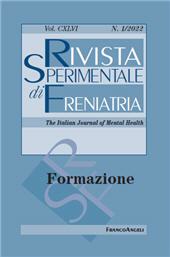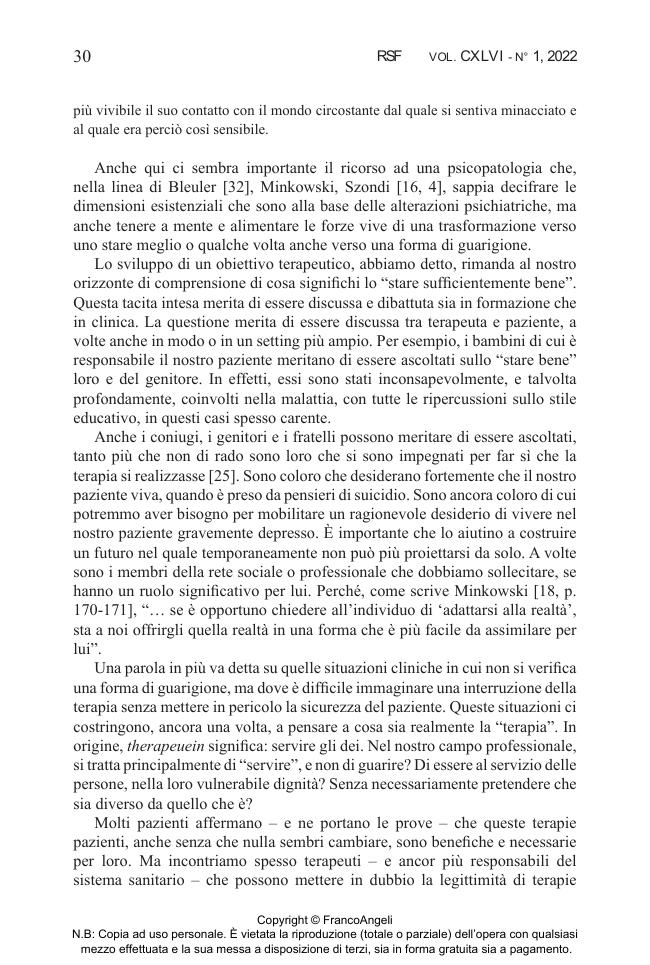Umane fratture, ambiti di cura, ambiti di formazione
13-46 p.
La formazione in psicoterapia è intrinsecamente modellata dal nostro modo di pensare all'essere umano. Che cosa, nell'esistenza umana, ci espone alla (psico)patologia? Cosa può essere considerato benefico e trasformativo nello scambio terapeutico? E analogamente quale atteggiamento nella formazione, così come nella terapia, potrebbe essere più umano? Facendo riferimento al pensiero fenomenologico, gli Autori esaminano lo statuto singolare attorno al quale ruotano la psicopatologia e la terapia: il fenomeno patico. Il "patico" si riferisce alla multiforme vulnerabilità che contraddistingue la nostra condizione umana e che segna anche la nostra apertura, la nostra fondamentale sensibilità a ciò che accade nell'incontro. La dimensione patica della malattia più che i sintomi costituisce la realtà immediata e pregnante per il paziente.
La terapia può essere definita come un movimento intersoggettivo di incontro, di comune cammino e di scambio, dove il terapeuta mette le sue conoscenze teoriche, il suo saper fare e la sua presenza al servizio della persona in cura, per tendere ad uno stare meglio con se stesso, con gli altri e nel mondo. Allo stesso modo, la formazione è chiamata a realizzare un incontro trasformativo tra formatori e studenti. La formazione in psicoterapia si baserebbe su questa iniziazione viva e pensante alla condizione umana: alla sua fondamentale natura "patica", segnata dalla possibilità sia della perdizione e dell'annientamento, che della fiducia e del compimento. Nel suo cammino, l'allievo deve poter contare non solo sull'esperienza, ma anche sulla relazione con formatori impegnati che lo sostengono e lo guidano, e sulla solidarietà attiva, sullo spirito cooperativo del gruppo dei compagni per affrontare il 'meraviglioso' e lo 'sconcertante' dell'incontro con il pathos. [Testo dell'editore].
Psychotherapy training is intrinsically shaped by the way we think about the human being. What, in human existence, exposes us to (psycho)pathology? What can be considered beneficial and transformative in the therapeutic exchange? And similarly, what approach in training, as well as in therapy, could be more humane? Referring to phenomenological thought, the authors examine the singular statute around which psychotherapy and therapy revolve: the pathic phenomenon. "Pathic" refers to the multiform vulnerability that characterizes our human condition and that also marks our openness, our fundamental sensitivity to what happens in the encounter. The pathic dimension of the illness more than the symptoms constitutes the immediate and meaningful reality for the patient.
Therapy can be defined as an intersubjective process of encounter, of common path and exchange, where the therapist places his or her theoretical knowledge, knowhow, and presence at the service of the person under treatment in order to strive for a better way of being with self, with others and in the world. In the same way, training is called upon to achieve a transformative encounter between trainers and students. Training in psychotherapy should be based on this living and thinking initiation to the human condition, to its fundamental "pathic" nature, marked by the possibility of perdition and annihilation as well as trust and fulfilment. In their journey, the students must be able to rely not only on experience but also on the relationship with committed instructors who support and guide them, and on the active solidarity and cooperative spirit of the group of companions to face both the 'wonderful' and the 'disconcerting' in the encounter with pathos. [Publisher's text].
Fa parte di
Rivista sperimentale di freniatria : la rivista dei servizi di salute mentale : CXLVI, 1, 2022-
Articoli dello stesso fascicolo (disponibili singolarmente)
-
Informazioni
Codice DOI: 10.3280/RSF2022-001002
ISSN: 1972-5582
PAROLE CHIAVE
- formazione, psicoterapia, psicopatologia, esperienza patica, vulnerabilità
- training, psychotherapy, psychopathology, pathic experience, vulnerability



